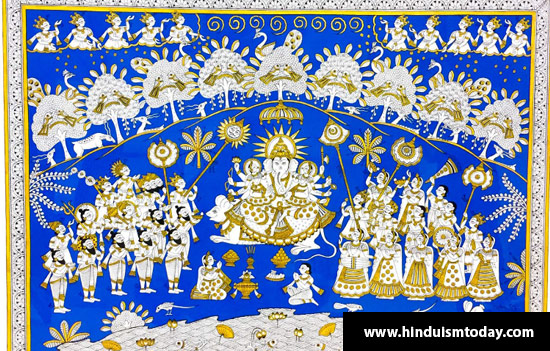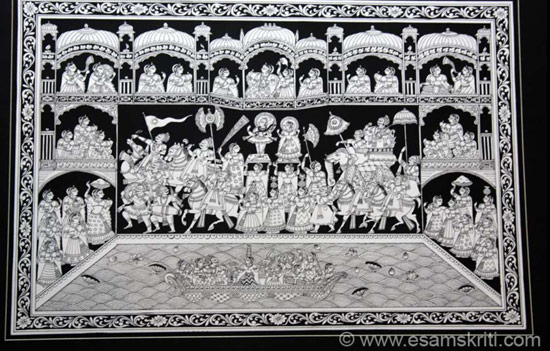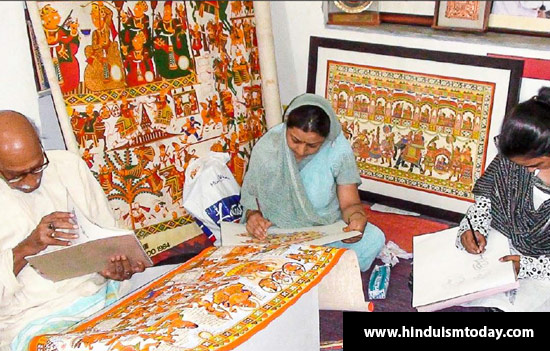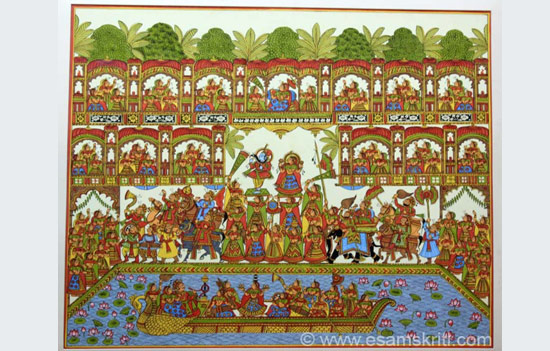- How a painting is started, made, technique? Role of Bhopa (priest singer). What makes Phad unique? Lovely pictures of Phad paintings.
In this unique and traditional art form, mythological stories and folk tales are meticulously illustrated on long canvas scrolls, some five feet high and 30 feet long. Each scroll or Phad (which means “fold” in the local dialect) depicts a sequentially narrated story dedicated to one or more of the Rajput Deities. But more than that, each is an expression of devotion and sanctity. Every stage of the making of the artwork overflows with religious traditions and rituals.
Commissioned
by a priest-singer (known as a Bhopa),
the painting, regarded as a traveling temple, is initiated with a prayer
offered to the Deity. The artist then begins his task, following strict
guidelines. The Bhopa accepts the completed painting with yet another elaborate
ceremonial prayer. Once the traditions and ceremonies are concluded, the
priest-singer, seen here with his stringed instrument, travels village to
village, singing and enacting the pictorial depiction of the Deity portrayed in
the holy painting, which he displays so villagers can follow his tale.
This article was
first published in Hinduism Today.
 Phad by Kalyan Joshi shows Lord Ganesha being worshiped by humans on Earth and devas in celestial realms.
Phad by Kalyan Joshi shows Lord Ganesha being worshiped by humans on Earth and devas in celestial realms.
Bhilwara,
Rajasthan, is the land of origin of Phad paintings, which can be traced back to
the tenth century. These paintings serve as portable temples, capturing a mass
of divinity in one scroll. Over the centuries, this painting genre has
successfully retained its distinct style and visual approach, having been
practiced exclusively by artists from the Nayak community, particularly the
Joshi family.
The
techniques and methodology were carefully kept only within the family, handed
down generation to generation with great caution. Only the sons of the
household were taught the craft. Since daughters would leave the family after
marriage, they assisted only with the preparation tasks-although
daughters-in-law, as new members of the clan, were permitted to learn and
practice the art.
In
recent years, however, fearing the disappearance of this art form from its
native land, many Joshi clan members have made generous efforts to share the
techniques with other artists. To perpetuate this art form and preserve its
distinguishing features and techniques, renowned artist Shree Lal Joshi, a
Padma Shri awardee, opened a school called Joshi Kala Kendra in 1960 so that
others could learn this art style. This school, now called Chitrashala, serves those who would help to supply the burgeoning
international demand for this art.
Folk
stories tell us that before setting out on a journey, Devnarayan (believed to be an incarnation of Lord Vishnu) fulfilled a devotee’s request by asking a Joshi from Bhilwara to depict his story in the form of a Phad. This was the first Phad ever created. Thereafter, Devnarayan assigned a Bhopa to narrate the story to his worshipers whenever requested. The nomadic Bhopas’ oral recital continues to this day. The Joshis themselves, however, believe that their ancestors were first commissioned by Chochu Bhat, a devotee of Lord Devnarayan and early mentor of Devnarayan’s clan.
 Phad by Prakash Joshi, displayed at Dastkari Festival, Pune. 2015.
Phad by Prakash Joshi, displayed at Dastkari Festival, Pune. 2015.
Spirituality and Rituals
The creation of a new Phad commences with a prayer ceremony in which the Bhopa’s commission for a new Phad is accepted by the artist. For an auspicious and favorable beginning, the first stroke of the painting is made by a girl child (kumari) who is considered pure and pious. She could be from the artists’ or any high-caste brahmin family. Afterwards she is offered new clothes and other gifts.
After
drawing a sketch of Ganesha, Saraswati and then Dasha Avatar (the ten
incarnations of Vishnu) on the canvas to invoke their blessings, the artist
spends weeks and months working tirelessly on the intricate art piece.
Finally, on an auspicious day, he invites the Bhopa and signs his name next to the central figure of the Deity portrayed in the painting. The Bhopa’s name is also added. As a last step, he paints the pupils of the main Deity’s eyes, bringing the painting to life and awakening the image of the divine being. The Phad, now a mobile temple, is then given to the Bhopa.
A performance by a Bhopa is revered as a religious ritual. The
priest-singer is invited by the villagers to invoke the Deities for their
blessings and ward off negativity, especially during difficult and unfortunate
times. The villagers bestow offerings in cash and kind upon the Bhopa.
In
preparation for the Jagaran (Phad
performance), the ground where the holy temple will be unfolded is cleaned and
purified with incense. Offerings, including money, grains and fruits, are made
in front of the mobile temple. Customarily, the Bhopa wears a special costume,
called Baga. The enthralling
performance usually starts right after sunset and proceeds throughout the
night, concluding at dawn with an arati, the passing of a blessed flame.
Commencing
with the invocation of the greater Gods-Ganesha, Saraswati and Vishnu-the
narration lasts for 9 to 12 hours, with short intervals for food and
interaction between the folk balladeer and the audience. The Bhopa pauses his
musical sermon each time he receives a donation, blowing a conch shell to
praise the donor and announce his name.
 A family creating in their home studio.
A family creating in their home studio.
The
story painting is displayed as a backdrop, while the Bhopa enacts and sings the
epic of heroism and honor, accompanying himself on a two-stringed fiddle-like
musical instrument. Meanwhile, his wife (Bhopi) moves close to the Phad and
holds an oil lamp near each episode as it is recited by the priest singer,
scene by scene, lighting it up against the night darkness.
After
years or decades of traveling and folding, a Phad naturally becomes stained and
worn. When that time comes, with reverence and fitting rituals, it is immersed
in the holy waters of the Ganga or Pushkar Lake. This ritual is called
Tandakarna, meaning cooling of the Godly powers.
Making of the Phad
The
canvas for a Phad must be durable, strong enough to survive harsh conditions
and last for years. For that purpose, the painters select handwoven cotton cloth,
called khadi. The coarse cloth is
soaked overnight to thicken the unprocessed threads, then starched with a paste
of boiled barley flour or rice. The stiffened material is then stretched and
dried in the sun.
After
the solidified cloth is cut to the required size, it is placed flat on a hard
surface and burnished with a moonstone attached to a wooden block. To make this
task easier, considering the size and thickness of the bristly cloth, the
wooden block has a weight of 45 to 90 pounds on top. The artist polishes the
cloth vigorously until he is satisfied that its finish is even, smooth and
glossy.
Technique and Color Scheme
Once the artist has prepared the cloth, he defines divisions and subdivisions on the canvas for the sequence of the tale. Notably, the scenes are not arranged randomly or in a linear fashion, nor are they trapped within frames like comic strips. Instead, they are carefully composed with respect to the viewer’s predictable eye movement and logical understanding.
Each
scene is first roughly sketched with a light yellow erasable paint, called kacha. The colors used are defined by
the age-old guidelines-orange for the figures, yellow for jewellery, green for
trees and vegetation, red for clothes and brown for animals and buildings, with
no use of gold or silver hues. The application of colors follows an order based
on their tonality, starting from the lightest tint to the darkest shade:
orange, yellow, green, brown, blue then red. The artist completes the painting
by outlining all the elements on the canvas with black, finally animating the
historical tale with life.
Traditionally,
the paints used by the Phad artists are organic,
sourced from natural elements like stones, flowers, plants and herbs. These
handmade tints are prepared by vigorously grinding pigments with gum and water
for a smooth and even paste. In recent times, however, many contemporary
artists have switched to synthetic pigments.
The Unique Style
The
Phad storyboarding style distinguishes it from all other folk art. There are
many subtle nuances that collectively build it as a narrative tale. For
instance, the size of the characters varies based on their social status and
the importance of the role they play in the story. In addition, the pictorial
events are cleverly interlinked. Figures may overlap from one scene to another,
and a common background may be used for consecutive episodes.
In
other common stylistic features followed by all Phad artists, every figure is
flat and two-dimensional, shown in profile, with large eyes and small noses.
Color, symbolism and size are used to identify important characters. Every inch
of the canvas is jam-packed with these vibrant, boldly outlined figures, yet
the storyboard effortlessly portrays the flow of its legends and events. Stylistic
similarities notwithstanding, each of these multi-layered masterpieces is
original and exceptional.
Theme and Symbolism
From ancient times the scrolls of Rajasthan’s folk Deities, like Pabuji, Devnarayan, Ramdevji, Mataji and Gogaji, have served as mobile shrines, taking sacred stories and culture to remote communities which have no formal temples.
The two most prevalent subjects are the traditions of Pabuji (said to be an incarnation of Lord Rama’s brother, Laxman) and Devnarayan (incarnation of Lord Vishnu). Both stories have well-developed narratives. Pabhuji and Devnarayan are always larger than the other figures; they wear red and are invariably shown on horseback as a symbol of holiness.
The
epic narrative Pabuji ki Phad, perhaps the best known Phad performance, is held annually at Pabusar, where the audience attendance is in thousands. This festive event is organized by the Jaipur Virasat. In this storyboard, Pabuji’s three courtiers are identified by the color of their horses and attire. Lord Siva, Pabuji’s horse and demons are painted in blue. While these performances are attended by people of all classes, this strict iconography helps unschooled villagers identify the color-coded characters more easily.
Changing Demand
The demand for Phads is dwindling fast in Rajasthan’s rural areas, as the next generation of Bhopas are opting for more lucrative professions. One of the last remaining contemporary priest-singers of Rajasthan was Mohan Bhopa, who passed away in 2011. He was known for his captivating and mesmerizing performances; his musical narration brought the Phad’s tale to life for audiences. This revered singer was featured in William Dalrymple’s best-selling non-fiction book, Nine Lives: in Search of the Sacred in Modern India. Currently, his wife
Batasi
performs with their son Mahavir, keeping the family tradition alive.
Despite
its dwindling use in Rajasthan, appreciation for the Phad art style has grown
worldwide. Art collectors are now demanding custom canvases. Thus, the paintings
are no longer made just for narrating the local sagas. Stories from other
popular epics and mythical tales are painted as well.
Common
themes include tales from popular epics like Ramayana, Mahabharata, Gita
Govinda and Hanuman Chalisa. Contemporary subjects like festivals and marriage
ceremonies have also become popular.
The paintings remain true to their basic principles. They are still religious in nature, and the techniques, including the formatting of intersecting scenes, are also unchanged. Notably, though, the size of these modern artworks is smaller, as the urban buyers’ purpose is home décor.
Full-time
career artists are few at present, though this art form is in high demand and
critically appreciated by art enthusiasts internationally. Fortunately, the
Joshi community members remain loyally determined to spread their rich, age-old
heritage. Workshops and presentations are held regularly on a national level.
Chitrashala (Phadchitrakari.com)
an established art institute in Rajasthan founded by Shree Lal Joshi, trains
artists in strict adherence to the age-old Phad style.
 Phad Painting by Prakash Joshi, displayed at Dastkari Festival, Pune. 2015.
Phad Painting by Prakash Joshi, displayed at Dastkari Festival, Pune. 2015.
Among today’s most celebrated Phad artists are Kalyan Joshi, Vijay Joshi, Pradeep Mukherjee and Nand Kishor Joshi. Their colorful mosaic-like paintings are available in online art galleries storyltd.com, mojarto.com and gallerymustart.com.
Other beautiful and artistic Phad paintings are available for sale at heartforartonline.com, dollsofindia.com, artisera.com, go4ethnic.com, theindiacrafthouse.com and
more.
This article was
first published in Hinduism Today and Here
eSamskriti has obtained permission from Hinduism Today to share.
To read all articles
on Traditional Indian Art
Also read
1.
Dastkari
Art Festival Pune
2.
www.phadchitrakari.com
3.
Kishangarh
school of painting, Rajasthan
4.
Pichwai
Art of Rajasthan
5.
Bundi
Fort Paintings
6.
Bundela
Paintings Orchha, Madhya Pradesh
7.
Nagaur Fort
Paintings, Rajasthan
8.
Rajasthan’s school of Miniature paintings